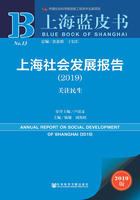
Abstract
The Party's 19th National Congress Report pointed out that the principal contradiction facing Chinese society has evolved. What we now face is the contradiction between unbalanced and inadequate development and the people's ever-growing needs for a better life. We are required to pay great attention to the welfare of the people's livelihood, complement the shortcomings of the people's livelihood in development, and promote social fairness and justice. Since the reform and opening up, Shanghai has been actively improving people's livelihood and welfare in education, housing, employment, medical treatment, social security and other aspects. The quality of life of the general public has been continuously improving. However, there are still insufficient and imbalanced problems, such as the shortage of high-quality educational resources and the large gap of 0-3-year -old kindergarten services, which have affected the people's fertility desire and caused the imbalance of the city's population structure to become more and more serious. Under the downward pressure of the economy, the employment contradiction is becoming more and more acute. Although the level of social security is constantly improving, there are still about 3 million employees who do not participate in social security. The sustainability of the social security system is facing great challenges. If these social contradictions and problems can not be well solved, they will directly affect the harmonious and stable development of Shanghai's social economy. Therefore, the annual theme of Shanghai Social Development Report 2019 is“Paying attention to people's livelihood”. This paper makes an in-depth analysis of the development process and existing problems of Shanghai's livelihood and welfare policies, and puts forward a series of forward-looking countermeasures and suggestions.
There are seven parts in this book. The first part is the general report. Based on the data of the 2018 Shanghai People's Livelihood Poll, this paper analyses the overall situation of people's livelihood in Shanghai, and puts forward some countermeasures and suggestions to promote employment, increase residents' income, improve the sustainability of social security, promote social integration and value identification.
The second part is the social development and urban management. It evaluates the overall situation of Shanghai's social development since the 13th Five-Year Plan, looks forward to the potential problems that Shanghai may face in terms of people's livelihood and social stability in the coming years, and puts forward countermeasures and suggestions to improve the level of urban management, consolidate the foundation of people's livelihood, deal with the interests of social strata, and control urban contradictions and risks.
The third part is the development of children and adolescents. Based on the data of the national fertility survey in 2017, this paper analyses the current situation and problems of the level of Shanghai, and puts forward a series of suggestions to improve the fertility welfare policy, the fertility desire and the fertility level. In this part, there are two chapters which focus on the healthy development of adolescents.
The fourth part is about employment and social security, using a large number of survey data to make a thorough analysis of the employment service situation and women's employment problems in Shanghai, and systematically analyze the development and existing problems of Shanghai's five major social security systems in 2011-2017, highlighting some aspects that need to be improved.
The fifth part is about social undertakings and social welfare. By using authoritative statistical data, the author makes a thorough analysis of Shanghai's compulsory education, community health service system development and precise poverty alleviation, and proposes forward-looking suggestions. In this part, another chapter studies the urban integration and development of strange wife, which is also an important issue related to the harmony and stability of marriage and family in Shanghai.
The sixth part is a case study, in which three chapters respectively introduce the experience of relying on the leadership of Party building, building“zero distance home”in Nanjing East Road Street of Huangpu District, discussing the community governance model of commercial buildings in Middle Huaihai Road Street of Huangpu District, and promoting innovation of social governance in Shiquan Road Street of Putuo District. There are two chapters in this part, which respectively introduce the situation of Yangpu District using social capital to promote the development of pension services and the construction of nursing staff.
The seventh part is the appendix, which records the social development process of Shanghai and several municipalities directly under the Central Government with statistical data.
Keywords: Social Development; Focus on People's Livelihood; Better Life